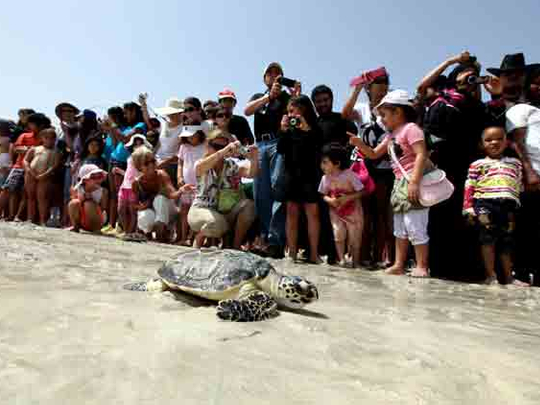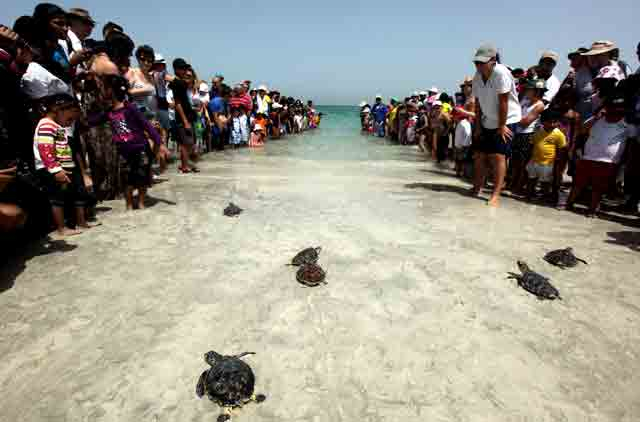
Dubai On the sun-drenched beaches of Ghantoot Reserve Friday, a bale of Hawksbill turtles checked out of hospital and made a beeline for the clear waters of the Gulf.
More than 600 onlookers watched as science teams from Emirates Marine Environmental Group (EMEG) and Jumeirah Group helped about 50 dinner-plate sized marine turtles go home.
The scene was inspiring as biologists gently liberated the turtles from grey plastic transport boxes and flippers automatically kicked into rowing mode even before turtle shells hit the wet sand.
Warm reaction from the crowd
The critters drew warm reactions from the crowd as some turtles paused, looked back for reassurance that other turtles were following, and then resumed their short jaunt into the watery chop.
Other turtles reversed gears but were quickly righted by staff to head for the surf. Hurrahs erupted on the sidelines as each turtle sank into the clear water lapping the shoreline.
Seven-year-old Hannah McShane was one happy youngster after witnessing the turtles' race to the surf yesterday morning.
"They were cute," Hannah told Gulf News.
UK expatriate Steve Hannah said he was extremely surprised to learn of the intensive rehabilitation efforts for the turtles, given the contrast of a nature preserve to that of a developing concrete city punctuated with skyscrapers and ringed with massive projects such as Palm Jebel Ali and Palm Jumeirah.
"Everyone sees Dubai sometimes as a manufactured city. These kinds of environmental things are rarely talked about, so it is good to see this going on," he said.
Appreciating environment
Susie Hannah said she was glad that her daughter was able to witness real recovery efforts in progress, noting that it will help her appreciate the environment for years to come.
"This is something good for the kids to learn early in their lives," she said.
The heartwarming race for the sea was the end result of months of work by biologists at the Jumeirah Group's Dubai Turtle Rehabilitation Centre to revive injured or ill Hawksbill turtles collected by EMEG monitoring patrols.
Major Ali Saqr Sultan Suwaidi, president of EMEG, was thrilled with the joint conservation efforts that led to the release yesterday of so many Hawksbill turtles, noting that for every turtle saved, there is hope for the future.
Nesting female population
Some estimates put the worldwide nesting female population of the Hawksbill turtle at only 8,000 despite UAE's efforts since 1999 to ban taking the turtle or its eggs.
He thanked the Burj Al Arab Aquarium for its rehabilitation efforts to save the marine creatures.
"We're very happy with the rehabilitation centre. They've been doing the science, we've been collecting the turtles for them," Suwaidi told Gulf News yesterday. "We have six monitoring teams walking the shores every day."
Suwaidi said that despite conservation efforts throughout the UAE, marine turtles are in harm's way given numerous threats to their survival.
Plastic garbage bags
Accidental netting by commercial fishermen (bycatch), growth of barnacles on shells and bodies, disease, pollution, development, and floating plastic garbage are all taking their toll.
"Plastic is a big problem," he said. "The turtles think plastic is a jellyfish and they eat it. It will kill them because they can't digest plastic."
Determining the health and size of the Hawksbill turtle in UAE waters is difficult but Suwaidi said the latest count estimated there were 370 nesting Hawksbill turtles in UAE waters.
UAE's hospital for turtles
Dubai When people get sick, they go to the nearest hospital.
When Hawksbill turtles wash up on UAE shores ill or injured, they're taken to Warren R Baverstock, operations manager at Jumeirah Group's Burj Al Arab Aquarium.
The aquarium is home to the Dubai Turtle Rehabilitation Centre which is gearing up for a massive return to the wild of 150 Hawksbill turtles on June 29.
Six Loggerhead sea turtles will also be affixed with satellite-tracking tags and released the same day. Adults and school children can follow the turtles' journey on the centre's website at www.facebook.com/turtle.rehabilitation.
Turtles' journey to be tracked
Baverstock told Gulf News that the centre is reaching out to 2,500 school children to encourage them to keep track of the turtles.
Numbers collected since the first Hawksbill turtles were released into the sea in 2004 show that 600 injured turtles have recovered owing to the centre's efforts.
Facts about turtles
- Only one in a thousand hatchlings survives until maturity (only one hatchling out of every 10 nests will survive to adulthood).
- There are two types of turtle commonly found in the Arabian Gulf, the Hawksbill and Green.
- A female turtle can lay between 60 and 150 eggs, depending on the species.
- Turtles will always try to return to the beach where they emerged to lay their eggs.
- Under UAE law, it is prohibited to capture sea turtles of all species or to collect their eggs. The penalty for doing so includes imprisonment and/or a heavy fine.













